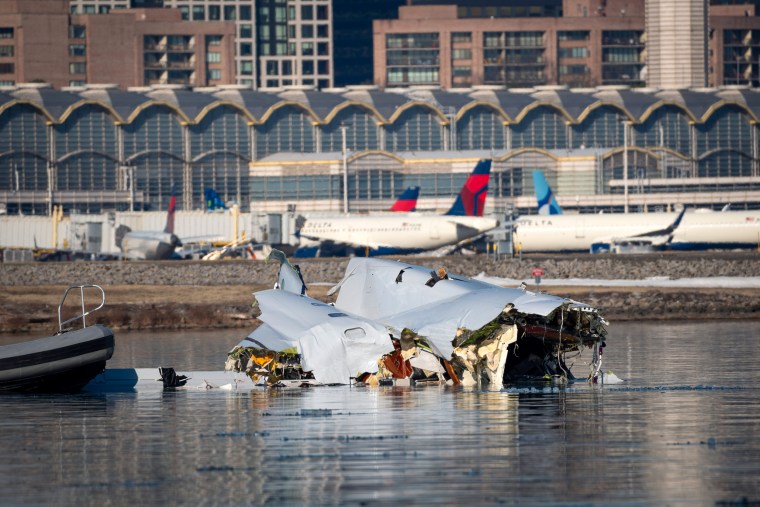
An aircraft engine and the fuselage belonging to American Airlines Flight 5432 were lifted out of the Potomac River on Monday, beginning the complex job of removing the last of the wreckage after a military helicopter collided with it and crashed last Wednesday.
Officials say that what remains of the jet needs to be removed from the crash site in order to recover all 67 victims who died in the midair collision in the Washington, D.C., area. The effort began Monday at sunrise, officials said.
So far, 55 victims’ remains have been positively identified, D.C. Fire and EMS Chief John Donnelly told a news conference Sunday: “We’re going to recover everyone.”
“If we knew where they were, though, we would already have them out, so we have some work to do as the salvage operation goes on, and we will absolutely stay here and search until such point as we have everybody,” he added. Recovery workers have been battling difficult conditions with near-zero visibility in the dark waters.
Additional remains were found during recovery efforts Monday and are in the process of being identified by the D.C. Office of the Chief Medical Examiner, D.C. Fire and EMS Assistant Chief Gary Steen said a news briefing Monday evening. Steen said he believes the rest of the human remains in the Potomac are within the wreckage.
The U.S. Army Corps of Engineers, Baltimore District, plans to lift the remains of the jet from the river in stages, a process that is expected to last three days. U.S. Secretary of Transportation Sean Duffy said he will be present for the wreckage removal Monday.

The operation will use a crane barge, deck barges, dive boats and two surface-supplied dive systems, the army said in a statement.
The American Airlines engine was removed from the Potomac and placed into a barge at around 10 a.m., Colonel Frank Pera of the U.S. Army Corps of Engineers Baltimore district said at Monday’s briefing. At noon, the fuselage of the plane was lifted out of the water.
The effort to remove one of the plane’s wings began at 2:30 p.m., Pera said, adding that he feels crews will reach that goal by the end of the day. On Tuesday, the goal is lift the cockpit out of the water.
Pera said Tuesday’s efforts may be impacted by weather, but he believes that crews are on track to achieve wreckage salvaging goals.
“That goal may be impacted tomorrow by a couple of environmental conditions, notably the wind,” Pera said. “But we’re going to stay conscious kind of where those gusts and sustained winds are, and we’ll make sure that we’re communicating that effectively.”
The wreckage will be taken to a hangar for the National Transportation Safety Board to continue investigating the cause of the collision.
Then the recovery teams will turn their attention to the remains of the Black Hawk helicopter. The “large lifts” portion of the operation is expected to be finished by Saturday, with the clearance of other debris lasting until at least Feb. 12. An automatic stop on this work will be ordered when a body is discovered.
“The level of coordination both behind the scenes and out on the Potomac is exceptional,” Baltimore District Commander Col. Francis Pera said. “We have not and will not lose focus of what is most important — the safety of our crews and accounting for those still missing to bring closure to their families and loved ones.”
The recovery timeline is, however, dependent on the availability of lifts, as well as weather and the tides.








